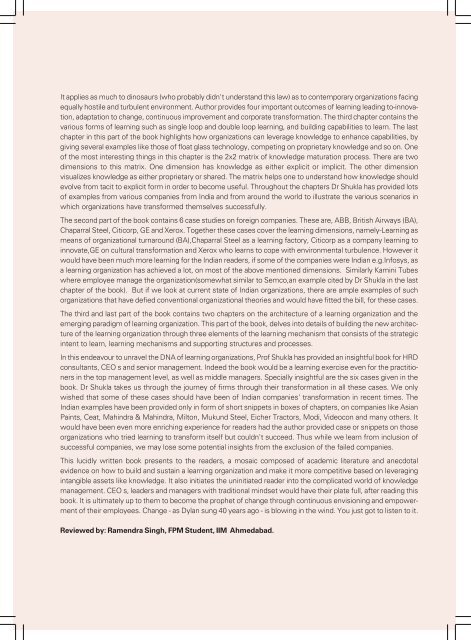NHRD Journal - National HRD Network
NHRD Journal - National HRD Network
NHRD Journal - National HRD Network
You also want an ePaper? Increase the reach of your titles
YUMPU automatically turns print PDFs into web optimized ePapers that Google loves.
It applies as much to dinosaurs (who probably didn't understand this law) as to contemporary organizations facing<br />
equally hostile and turbulent environment. Author provides four important outcomes of learning leading to-innovation,<br />
adaptation to change, continuous improvement and corporate transformation. The third chapter contains the<br />
various forms of learning such as single loop and double loop learning, and building capabilities to learn. The last<br />
chapter in this part of the book highlights how organizations can leverage knowledge to enhance capabilities, by<br />
giving several examples like those of float glass technology, competing on proprietary knowledge and so on. One<br />
of the most interesting things in this chapter is the 2x2 matrix of knowledge maturation process. There are two<br />
dimensions to this matrix. One dimension has knowledge as either explicit or implicit. The other dimension<br />
visualizes knowledge as either proprietary or shared. The matrix helps one to understand how knowledge should<br />
evolve from tacit to explicit form in order to become useful. Throughout the chapters Dr Shukla has provided lots<br />
of examples from various companies from India and from around the world to illustrate the various scenarios in<br />
which organizations have transformed themselves successfully.<br />
The second part of the book contains 6 case studies on foreign companies. These are, ABB, British Airways (BA),<br />
Chaparral Steel, Citicorp, GE and Xerox. Together these cases cover the learning dimensions, namely-Learning as<br />
means of organizational turnaround (BA),Chaparral Steel as a learning factory, Citicorp as a company learning to<br />
innovate,GE on cultural transformation and Xerox who learns to cope with environmental turbulence. However it<br />
would have been much more learning for the Indian readers, if some of the companies were Indian e.g.Infosys, as<br />
a learning organization has achieved a lot, on most of the above mentioned dimensions. Similarly Kamini Tubes<br />
where employee manage the organization(somewhat similar to Semco,an example cited by Dr Shukla in the last<br />
chapter of the book). But if we look at current state of Indian organizations, there are ample examples of such<br />
organizations that have defied conventional organizational theories and would have fitted the bill, for these cases.<br />
The third and last part of the book contains two chapters on the architecture of a learning organization and the<br />
emerging paradigm of learning organization. This part of the book, delves into details of building the new architecture<br />
of the learning organization through three elements of the learning mechanism that consists of the strategic<br />
intent to learn, learning mechanisms and supporting structures and processes.<br />
In this endeavour to unravel the DNA of learning organizations, Prof Shukla has provided an insightful book for <strong>HRD</strong><br />
consultants, CEO s and senior management. Indeed the book would be a learning exercise even for the practitioners<br />
in the top management level, as well as middle managers. Specially insightful are the six cases given in the<br />
book. Dr Shukla takes us through the journey of firms through their transformation in all these cases. We only<br />
wished that some of these cases should have been of Indian companies' transformation in recent times. The<br />
Indian examples have been provided only in form of short snippets in boxes of chapters, on companies like Asian<br />
Paints, Ceat, Mahindra & Mahindra, Milton, Mukund Steel, Eicher Tractors, Modi, Videocon and many others. It<br />
would have been even more enriching experience for readers had the author provided case or snippets on those<br />
organizations who tried learning to transform itself but couldn't succeed. Thus while we learn from inclusion of<br />
successful companies, we may lose some potential insights from the exclusion of the failed companies.<br />
This lucidly written book presents to the readers, a mosaic composed of academic literature and anecdotal<br />
evidence on how to build and sustain a learning organization and make it more competitive based on leveraging<br />
intangible assets like knowledge. It also initiates the uninitiated reader into the complicated world of knowledge<br />
management. CEO s, leaders and managers with traditional mindset would have their plate full, after reading this<br />
book. It is ultimately up to them to become the prophet of change through continuous envisioning and empowerment<br />
of their employees. Change - as Dylan sung 40 years ago - is blowing in the wind. You just got to listen to it.<br />
Reviewed by: Ramendra Singh, FPM Student, IIM Ahmedabad.<br />
130<br />
November 2007 <strong>N<strong>HRD</strong></strong> <strong>Journal</strong>
















